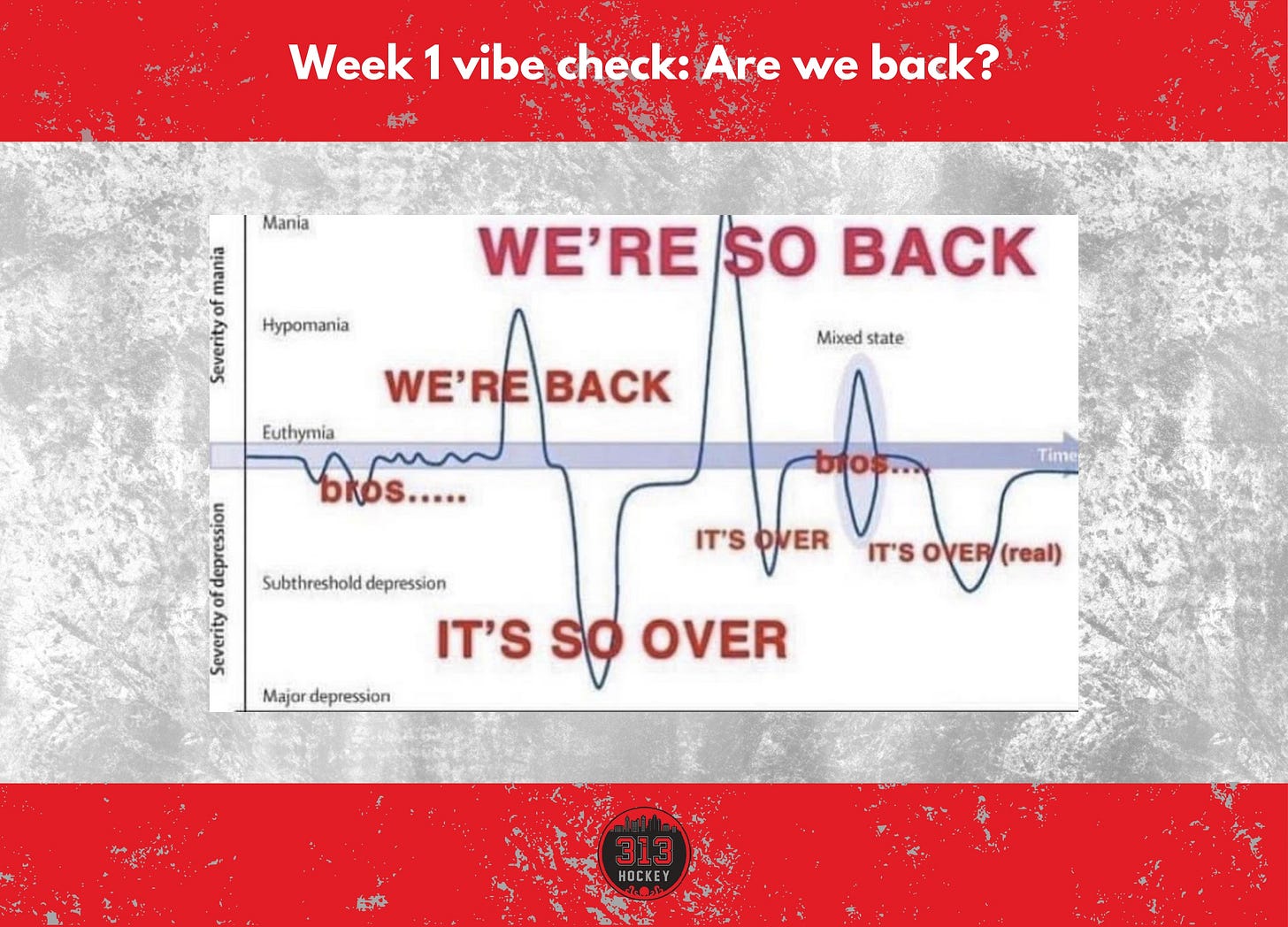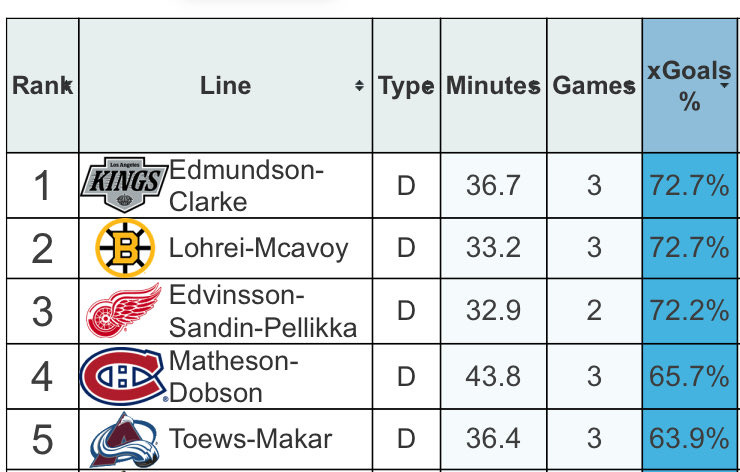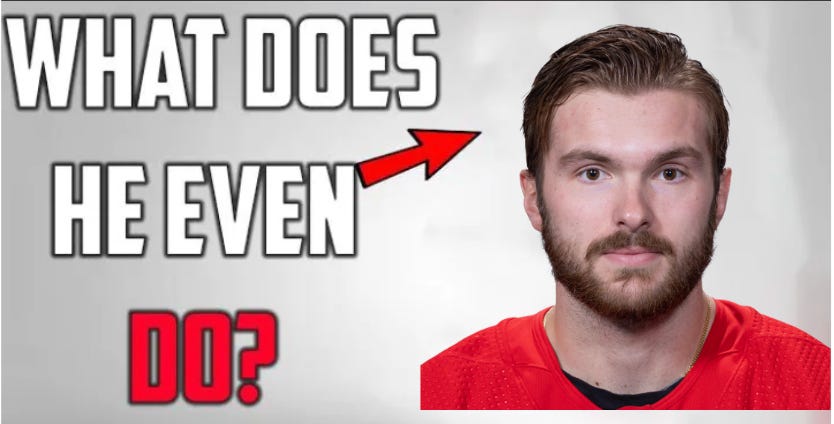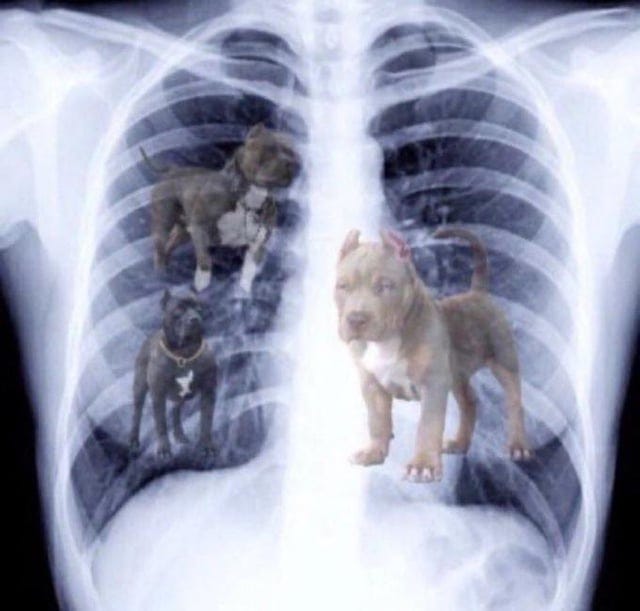Week 1 vibe check: Are we back?
The wallet inspector said he'd bring my wallet back any minute now
Over the last three seasons, watching the Detroit Red Wings has felt a lot like Charlie Brown with the football. Maybe this time he’ll get to kick the ball-oh, no, Lucy tricked him again and he’s fallen flat on his face.
But could this year be different?
We are three games into the season, so making any long-term assumptions is a losing game at best. After all, the Tampa Bay Lightning currently sit 27th in league standings. Still, despite the small sample size, there’s a lot to be excited (and concerned) about early on.
Let’s talk about it!
The youth movement is here to stay
This year was the first time in nearly a decade that the Red Wings allowed three rookies to make the roster on opening night. Emmitt Finnie, Michael Brandsegg-Nygard, and Axel Sandin-Pellikka have taken their auditions and ran with it.
Finnie, a former seventh-round pick, plays on the top line with Lucas Raymond and Dylan Larkin. With two points in three games, the flashy forward has shown some serious aggression on the forecheck. It’s not every day a guy forces his way onto the top line. It’s even rarer to do so as such a late-round pick. While rookie slumps are inevitable, his current pace is nothing short of exciting.
Michael Brandsegg-Nygard, drafted in the first round two seasons ago, plays like a veteran. He leads the Red Wings in hits with nine in three games and consistently drives the play on the third line. He hasn’t shown up on the score sheet just yet, but it seems like a goal is almost inevitable over the next few games.
Ask yourself: when was the last time you were genuinely excited to watch the third line hit the ice for the Wings? You can thank MBN for that one.
Let’s talk about Sandin-Pellikka
Up until Sunday’s showing against the Toronto Maple Leafs, the Simon Edvinsson-Axel Sandin-Pellikka pairing was among the best defensive pairings in the NHL. On Sunday, however, ASP had a less-than-stellar game. The Leafs frequently beat him on the forecheck and his turnovers resulted in at least one goal by Toronto.
Having said that, it’s very important to note that he’s a rookie defenseman. ASP is under greater pressure than any of the other rookies on the roster. He has to play longer shifts with greater disparity of talent on the other end of the ice all while remaining responsibly aggressive. To say he’s shouldering a massive burden is an understatement.
Anyone that’s watched ASP play for more than a few games can attest that the Swede improves every period. That’s what makes him such a particularly special player; he’s able to adjust under any circumstance. Realistically, we’ll see a few more of these games from ASP. But their frequency will almost certainly decrease as the season continues.
The Red Wings have a special player on their hands with Sandin-Pellikka.
The vets leave a lot to be desired
On the other side of the coin, we’re seeing more of the same from the veterans. It’s become so obvious, in fact, that even head coach Todd McLellan had to speak his mind.
“The players will say, ‘they probably have already said to you, ‘We can fix this.’ …When? It’s time. Some of them have been doing it for years. It’s time.”
This was, of course, after the embarrassment of a home opener when the Montreal Canadiens demolished the Wings 5-1. On its own, it might come across as a passionate moment from a frustrated coach, but it points to a bigger problem the Wings have dealt with for years.
The biggest problem the Wings have dealt with is a lack of confidence and consistency. Traditionally, younger players are expected to rely on veterans for support when the going gets tough. But, if the vets can’t step up, the younger players have no choice but to take the reins. (More on this later.)
The 6’6” elephant in the room
Let me ask you a question: can you name for me one time where Michael Rasmussen did something genuinely impressive last season? The time he hit Jack Hughes was pretty cool, but, other than that, I can’t think of a time he’s been a key difference-maker in an important game. While, again, we’re working with a very small sample size here, the former first-round pick has yet to establish himself as anything more than a solid fourth liner.
Worse yet, he’s just signed a three-year deal with the Red Wings. Is there some sort of clause in Steve Yzerman’s contract where he has to have at least 1-3 mediocre players in the lineup at all times? Maybe Ras can prove me wrong (and I certainly hope he will). But, from what we’ve seen so far, he is what he is: a big, tall player that can’t hit, can’t score particularly well, and can’t play very good defense.
Eventually, something’s gotta give.
The Wings need a dog
One thing that’s remained remarkably consistent in the last few Stanley Cup winners is an attack dog-type player. The Florida Panthers have Sam Bennett (and Brad Marchand, to an extent). The Colorado Avalanche had Gabriel Landeskog. Before that, the Lightning employed Pat Maroon. Who do the Wings have? Who can step up to the plate when a mediocre player, say, cross-checks Lucas Raymond in the back?
The closest thing we have right now is Simon Edvinsson. Here’s a clip of him waving bye bye to Matthew Knies after depositing an empty net goal.
Ed’s a terrific player, but the attack dog will, more often than not, spend a little bit of time in the penalty box as a result. With an already porous defensive core, can the Wings truly count on the penalty kill sans Edvinsson? They need to find their solution elsewhere, lest they risk a few untimely power play goals.
Fortunately, the answer to their problems is waiting in the wings: Carter Mazur, who just scored a hat trick in his season debut for the Griffins, is a bona fide dog. He’s got the snarl they need with a nice scoring touch to boot. But will Yzerman really let four rookies make the roster this season? It remains to be seen. Still, if it’s sandpaper grit they’re after, Mazur’s the most pragmatic solution to the problem.
Conclusion: It’s do or die
We’ve reached an impasse in Hockeytown. The vets aren’t playing up to standards, but the youth hasn’t shown they’re ready to take the reins. This, in my casual estimation, is the year that the younger players finally take the burden that’s so often held by the vets.
Many of the younger players like Moritz Seider have been forced into sink or swim territory and have thrived from it. Now that they’ve established themselves, it’s up to them to help the next wave of rookie talent get acclimated to NHL speed. The team cannot rely on veteran leadership like Ben Chiarot or J.T. Compher anymore.
There’s a reason Seider and Lucas Raymond have the “A” on their jerseys. They’re the leadership now. It’s up to them to show they’ve earned it. Like their rookie campaigns, it’s sink or swim from here on out. That means taking accountability when losses happen and celebrating when the wins come. The destiny of the Detroit Red Wings rests in the hands of team leadership.
Maybe this time, Charlie Brown will finally get to kick the football.
Or maybe I’m the fool again.
Only one way to find out, I guess.







We await your prognostications and revelations